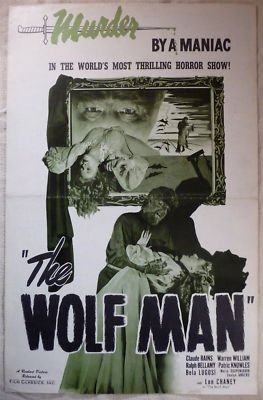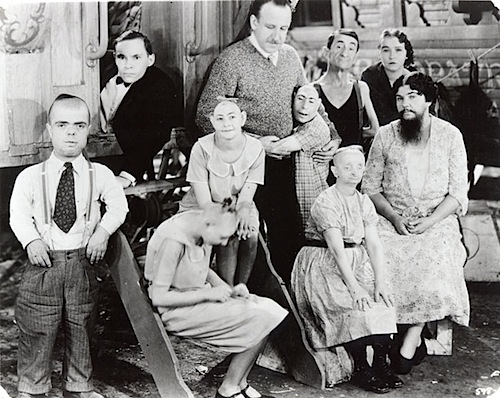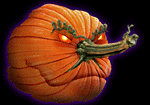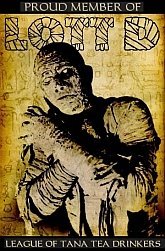Of the three major Universal Studios monster movies, Dracula, Frankenstein, and The Wolf Man, The Wolf Man did not spring from a notable novel. While many legends of werewolves abound in print, it took the skill of screenwriter Curt Siodmak, the talent of makeup artist Jack Pierce, and the acting of Lon Chaney Jr to tell the story of a man doomed by an eternal curse to kill the ones he loves by the light of the full moon.
The Wolf Man was originally intended as a vehicle for Boris Karloff, but as often happens in Hollywood, intentions change, as well as script ideas. Only the title remained as the movie was eventually assigned to director George Waggner and scriptwriter Curt Siodmak. While Waggner's uninspired and straightforward direction is adequate, it is Siodmak, first drawing on European Folklore, then creating his own, who weaves a fairytale spun out of Greek tragedy, blooming wolfbane, moonlight, and a sympathetic, doomed hero.
Lon Chaney Jr has the distinction of being the only actor to portray the tragic Larry Talbot, cursed to change into the Wolf Man and kill against his will, in five of Universal's horror offerings, thus making the role uniquely his own. His sympathetic performance as Lennie in Of Mice and Men typecast him as a hulking, sympathetic type, but that proved a perfect fit for his portrayal of the agonized, guilt-ridden Talbot and his demonic alter-ego.
 Americanized Larry Talbot returns to his ancestral home in Wales, after eighteen years of estrangement, when his brother dies. His prim and proper father, Sir John Talbot (Claude Rains), hopes that Larry will take over the duties of his family now, and that the two will reconcile their long-standing differences. In the first version of the script, the Mutt and Jeff look—as Tom Weaver describes it in his amusing commentary for the film—of the tall and thick Chaney next to the whispy, more delicate Rains was better explained; Chaney originally played an American engineer visiting Talbot Castle to work on Sir John's telescope. However, as the relationship changed story-wise, the physiques and family resemblance didn't.
Americanized Larry Talbot returns to his ancestral home in Wales, after eighteen years of estrangement, when his brother dies. His prim and proper father, Sir John Talbot (Claude Rains), hopes that Larry will take over the duties of his family now, and that the two will reconcile their long-standing differences. In the first version of the script, the Mutt and Jeff look—as Tom Weaver describes it in his amusing commentary for the film—of the tall and thick Chaney next to the whispy, more delicate Rains was better explained; Chaney originally played an American engineer visiting Talbot Castle to work on Sir John's telescope. However, as the relationship changed story-wise, the physiques and family resemblance didn't.
That trifling incongruency aside, the red, white, and blue Larry, of course, is more focused on the gorgeous woman (Evelyn Ankers) he spies through the lens of the telescope. Seems like Larry's a bit of wolf before he's even bitten.
When he visits Gwen's (Ankers) antique shop in town, he buys a walking stick decorated with the head of a wolf and the symbol of a pentagram in silver, which prompts a discussion of werewolves and the first recitation of Siodmak's brilliant folklore-sounding poem;
Even a man who is pure in heart and says his prayers by night may become a wolf when the wolfbane blooms and the autumn moon is bright.
Later that night, as fate would have it, Larry is bitten by a werewolf when he tries to save Gwen's friend from an attack by what he thinks is a wolf. Maleva, the Gypsy crone (the sublime Maria Ouspenskaya) tells him that her son (Bela Lugosi) was a werewolf, and now he, too, is cursed. Lugosi, in his role as Bela the Gypsy, has only seven lines to say, but makes the most of it. Which is kind of ironic when you think that he finally gets a role after Dracula that makes good use of his singular accent. Lugosi originally wanted to play the lead role, but that would have made an even more incongruent relationship between Sir John and Larry, so he was offered the key role of werewolf catalyst instead.
Sure enough, Larry soon succumbs to his curse of lycanthropy, and starts seeing pentagrams—the mark of death—on the hands of those he loves. His father doesn't believe any of this superstitious nonsense, but people start dying when Larry changes into the Wolf Man and goes on the prowl.
Universal, wanting another memorable monster to add to their A-list, changed the initial ambiguity of the script, which left the audience wondering whether Larry was a real werewolf or just thought he was one, and had Jack Pierce take his previous, more human-like makeup for Henry Hull in Werewolf of London and go hog-wild with it here.
Pierce's unique stylization makes the werewolf come alive with a feral humanity sorely missing in today's CGI-generated lycanthropic concoctions. The painstaking lap dissolve process that appears for seconds on screen actually took hours of laborious filming as layers of Yak hair were applied to Chaney's face and photographed. During the procedure, Chaney had to lie very still and in the same position, and probably would have loved to take a bite out of Pierce during the process. But the ground-breaking end-result is worth it, and the procedure improved in the course of subsequent films.
The mist-enshrouded forest set, designed by Jack Otterson, with its gnarled tree limbs and unnatural, dark landscape, gives The Wolf Man a claustrophobic and surreal tone of brooding isolation, and provides the perfect stage for Larry Talbot as he struggles against his estrangement from the townspeople, his father, and his crumbling peace of mind and normal way of life.
Heightening this feeling of dread and pacing the tension well, the now familiar music—which was subsequently used in many Universal movies including the Sherlock Holmes series—with its ominous, tri-toned opening beat followed by precipitous drum rolls, alarming horns, and emotive strings, is a classy addition to the modest production and enhances the action scenes as well as the quieter moments of impending doom.
Finally meeting his death at the hands of his shocked father, who beats him with the silver headed cane used to kill Bela the Gypsy, the climax of The Wolf Man stands out in its depiction of a man tragically caught in an evil cosmos with no way out. Lon Chaney Jr. reprised his signature role as the Wolf Man in four more Universal films, but The Wolf Man remains his most poignant performance as Larry Talbot, an ordinary man cursed, through no fault of his own, to walk on padded-feet by night, when the moon beckons, with the unquenchable thirst for blood.
Universal's Legacy Collection of The Wolf Man contains Tom Weaver's revelatory commentary, as well as the light, but informative documentary entitled Monster by Moonlight, narrated by John Landis, who directed American Werewolf In London.
Weaver sheds light on the love-not-lost relationship between Ankers and Chaney, though they starred in many films together, as well as the differences between the initial script and the final shooting one. He also points out the bloopers, always an enjoyable, "how'd I miss that moment," and the little behind the scenes tidbits that make for a more informed viewing of this classic horror film.
One thing I was hoping Weaver would touch on but didn't is the perplexing way the Wolf Man invariably wound up dressed in a neatly pressed dark shirt and pants after every transformation into the hirsute terror. That one always perplexed me. Stylish, but still perplexing.
The set also includes the sequel and first Universal Studios ensemble film, Frankenstein Meets the Wolf Man, as well as Werewolf of London and She-Wolf of London. Makes you kind of wonder what's going on over at London, doesn't it. Disappointingly enough, they didn't include 1948's Bud Abbot Lou Costello Meet Frankenstein, the enjoyable last hurrah for Universal's era of classic horror.


 We hurried into the theatre to get good seats for the show—the place was starting to get crowded—and Zombos ran smack into Creighton from Ghoul a Go Go. He was incognito of course, all six feet six inches of him. I picked Zombos up, brushed him off, and we found two excellent seats. Zombos mumbled something about Creighton being Tor Johnson’s illegitimate brother, but I kept him from causing a scene.
We hurried into the theatre to get good seats for the show—the place was starting to get crowded—and Zombos ran smack into Creighton from Ghoul a Go Go. He was incognito of course, all six feet six inches of him. I picked Zombos up, brushed him off, and we found two excellent seats. Zombos mumbled something about Creighton being Tor Johnson’s illegitimate brother, but I kept him from causing a scene.


 Are you into making monsters?
Are you into making monsters?  Horror author and Monster Kid Tim Curran freely, and of his own will, steps into the closet after his long terror-filled voyage in Dead Sea to talk about his latest novel, and the singular craft of writing horror.
Horror author and Monster Kid Tim Curran freely, and of his own will, steps into the closet after his long terror-filled voyage in Dead Sea to talk about his latest novel, and the singular craft of writing horror. In your novel, Hive, you wrote a sequel to Lovecraft's At the Mountains of Madness. What is it about Lovecraft's work that led you to do that?
In your novel, Hive, you wrote a sequel to Lovecraft's At the Mountains of Madness. What is it about Lovecraft's work that led you to do that?






 I went down to the front door, opened it, and found the groundskeeper waiting for me. He tossed a small package into my hands.
I went down to the front door, opened it, and found the groundskeeper waiting for me. He tossed a small package into my hands.


